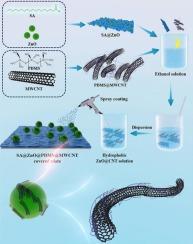改性碳纳米管与氧化锌协同增强超疏水TPU涂层的设计及长效防冰机理
IF 6.9
2区 材料科学
Q2 CHEMISTRY, PHYSICAL
引用次数: 0
摘要
本研究以聚氨酯(TPU)为界面增强相,通过聚二甲基硅氧烷(PDMS)改性多壁碳纳米管(MWCNT)和硬脂酸改性氧化锌(SA-ZnO)的协同作用,构建了具有梯度交联结构和低表面能的超疏水防冰涂层。TPU-13SZPC涂层的实验结果表明:复合涂层的静态接触角达到158.6 ± 0.8°;在−15℃时,表面水滴结冰时间延迟至612 s,比纯TPU的结冰时间延长970 %。此外,涂层经过30次砂纸磨损和24 h的酸碱腐蚀后,接触角保持在 >; 150°,表现出优异的机械和化学稳定性。机理分析表明,分子动力学(MD)模拟显示了不同TPU-SZPC涂层表面水分子相对浓度的变化,证实了不同TPU-SZPC比例的疏水效果。微纳多层结构和光热性能的协同作用显著抑制了冰核的形成。此外,密度泛函理论(DFT)证实了pdms修饰的MWCNTs具有优越的光热转换性能。随着pdms修饰的多壁碳纳米管含量的增加,涂层的整体光热性能得到增强。该研究为开发极端环境条件下的长效防冰/除冰材料提供了新的见解。本文章由计算机程序翻译,如有差异,请以英文原文为准。

Design and long-term anti-icing mechanism of superhydrophobic TPU coatings synergistically enhanced by modified carbon nanotubes and zinc oxide
In this study, a superhydrophobic anti-icing coating with a gradient cross-linking structure and low surface energy was constructed by using polyurethane (TPU) as the interfacial reinforcing phase, and through the synergistic effect of polydimethylsiloxane (PDMS)-modified multi-walled carbon nanotubes (MWCNT) and stearic acid-modified zinc oxide (SA-ZnO). The experimental results of TPU-13SZPC coating show that: the static contact angle of the composite coating reaches 158.6 ± 0.8°; the icing time of surface water droplets is delayed to 612 s at −15 ℃, which is 970 % higher than that of pure TPU. In addition, the coating maintained a contact angle > 150° after 30 times of sandpaper abrasion and 24 h of acid and alkali corrosion, demonstrating excellent mechanical and chemical stability. Mechanistic analysis revealed that molecular dynamics (MD) simulations demonstrated changes in the relative concentration of water molecules on the surfaces of different TPU-SZPC coatings, confirming the hydrophobic effects of varying TPU-SZPC ratios. The synergistic effects of micro-nano multi-level structures and photothermal performance significantly suppressed ice nucleation formation. Additionally, density functional theory (DFT) confirmed that PDMS-modified MWCNTs exhibit superior photothermal conversion performance. As the content of PDMS-modified multi-walled carbon nanotubes increases, the overall photothermal performance of the coating is enhanced. This study provides new insights for the development of long-lasting anti-icing/de-icing materials under extreme environmental conditions.
求助全文
通过发布文献求助,成功后即可免费获取论文全文。
去求助
来源期刊

Applied Surface Science
工程技术-材料科学:膜
CiteScore
12.50
自引率
7.50%
发文量
3393
审稿时长
67 days
期刊介绍:
Applied Surface Science covers topics contributing to a better understanding of surfaces, interfaces, nanostructures and their applications. The journal is concerned with scientific research on the atomic and molecular level of material properties determined with specific surface analytical techniques and/or computational methods, as well as the processing of such structures.
 求助内容:
求助内容: 应助结果提醒方式:
应助结果提醒方式:


